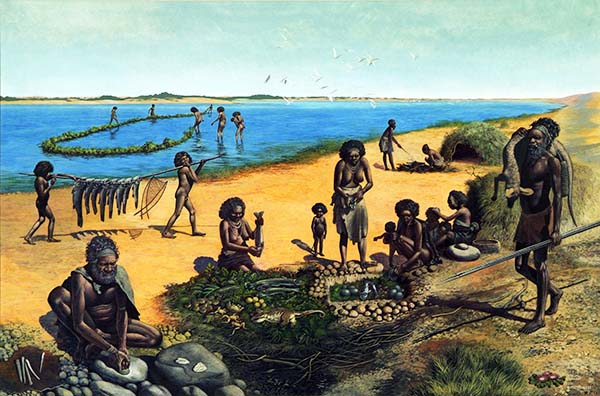
| Search JoyZine with Google Site Search! |
New Age for Mungo Man:
In the hot, drought-affected summer of 1969 a young Jim Bowler was exploring the as yet unnamed area around Lake Mungo. He was searching for ancient lakes that could yield vital clues to the effect of the ice ages on the Australian continent. It was on this expedition that he stumbled across the charred skeleton of Mungo Lady. Six years later he found a second complete skeleton just 300 metres from where he'd discovered Mungo Lady. The new find became known as Mungo Man. In 1999, Australian National University scientists estimated the age of Mungo Man to be 62,000 years. This created a frenzy of excitement and vigorous debate among scientists, as this date rewrote the history of human occupation in Australia and had profound implications for the origins of modern man. To solve the long-standing debate, Professor Bowler assembled a multidisciplinary team of experts from the Universities of Melbourne, Adelaide, Wollongong, the Australian National University, CSIRO and the NSW National Parks and Wildlife Service, and used multiple methods and four separate dating laboratories to achieve a final consensus. The results of this study have finally brought scientists into agreement on the age of Mungo Man—and the consensus is that he is 22,000 years younger than previously thought. Mungo Man's new age is 40,000 years. The research also boosted the age of Mungo Lady, the world's first recorded cremation, by 10,000 years—putting her at the same age as Mungo Man. The Lake Mungo skeletons nevertheless are still Australia's oldest human remains. And Mungo Man is still the first well-dated evidence found anywhere in the world of such cultural sophistication—in this case the anointing of the body with ochre before or during burial. Furthermore, as Prof Bowler put it: "The new age corrects previous estimates and provides a new picture of Homo sapiens adapting to deteriorating climate in Australia." The oldest evidence for human occupation of the Lake Mungo region has been dated from stone tools at about 50,000 years. This is consistent with the oldest artifacts found in Western Australia and Northern Territory. "Lake Mungo confirms that the first Australians had colonised the country by 50,000 years and by 40,000 years had brought with them art and ritual burial," he says. The data show that maximum human occupation of Lake Mungo occurred between 45,000 and 42,000 years ago, a time when the lake was a lavish water and food supply for humans, animals and plants. This phase of intense occupation occurred at a time of major climatic change that also coincided with the disappearance of Australia's megafauna. Between 60,000 and 50,000 years ago, the last ice age saw the expansion of freshwater lakes across what are now dry inland plains. By 45,000 years ago however the system was beginning to change. By 40,000 years, at the time of both burials, the onset of drought conditions was associated with the expansion of Australia's desert dunes, building to its maximum impact about 20,000 years ago. "By 20,000 years, the lakes were dry, plants and animals were decimated and sand dunes had spread across the plains", according to Bowler. "The new dates reveal a rich tapestry of archaeological change that is rarely equaled elsewhere in the world, and provide an ancient example of humans being forced to adapt to severe drought conditions similar to those that affect much of semi-arid and arid Australia today." Today, we are left with a dry lakebed and many important fossils. Indigenous Australians, however, survived the severe conditions and their account is one of the great stories of the peoples of the world. Mungo Man has changed the way we view indigenous history. Professor Bowler has developed a multi-media CD that explores the geological, archaeological and scientific history of the Willandra Lakes. It examines what is known of Australia's ice age environment when inland temperatures were 6-10 degrees below today's average temperatures. It explores the culture and history of the original inhabitants and examines the tensions between science and indigenous traditions that have today led to a new synthesis between ancient and modern cultures. "This research extends far beyond mere academic interest. The Mungo people's story is of major importance to both their present-day indigenous descendants and to all non-indigenous Australians," says Bowler. "Non-indigenous Australians too often have a desperately limited frame of historical reference. The Lake Mungo region provides a record of land and people that we latter day arrivals have failed to incorporate into our own Australian psyche. We have yet to penetrate the depths of time and cultural treasures revealed by those ancestors of indigenous Australians." "The messages from the ancient Mungo people challenge us to come to terms with the history and dynamics of this strange land, especially with the rights and richness of their descendants. "Indeed, it is those descendants, in the person of the three traditional tribal groups of the Willandra region (the Barkandji, the Mutthi Mutthi and the Nyampaa) who facilitated and cooperated closely with this project. This represents an important new phase in the collaboration between science and traditional owners. Science and the Australian community owe them a special debt of gratitude." Media Contact Lake Mungo—Virtual history on CD: available through Melbourne University Publishing or by contacting Jim Bowler |
